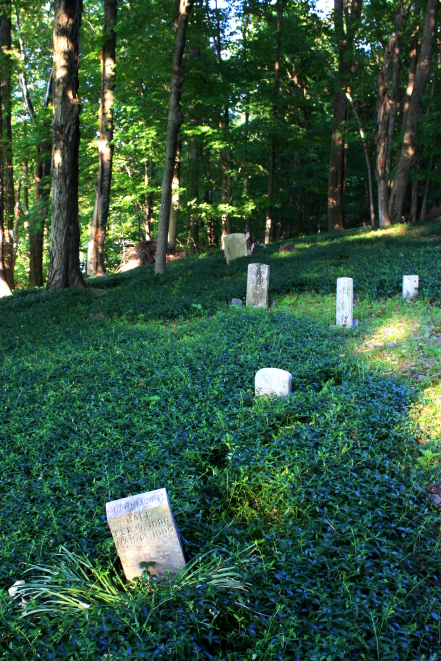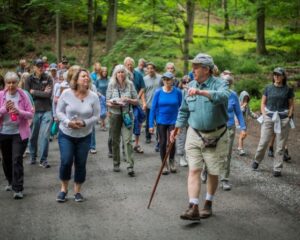Mount Moriah Church was located on Stoney Hill Road near the intersection of W. Mechanic Street in New Hope. The earliest record of Mount Moriah dates to 1818, when the church had 33 congregants. That makes Mount Moriah the third church of any denomination to be established in Solebury (New Hope was a part of Solebury until 1836), preceded only by the Solebury Friends Meeting and the Solebury Presbyterian Church. The church was surrounded by a small but long-established black community. Edward Smith, a preacher at Mount Moriah, was probably the first Black man to own property in Solebury when he purchased a small lot near William Maris’ cotton mill in 1825, and the American Methodist Episcopal congregants may have met in his home before the church was able to purchase its own property. In the early days, they also met at building called the Academy on Ferry Street, and the famous preacher Jarena Lee wrote about speaking there. Lee was the first female preacher approved by the AME.
They finally built their first church building in 1837. The deed for the church property specifically limits the use of the plot to “a site for a meeting house or church and graveyard wherein to bury people of colour of the African race and for no other use extent or purpose whatsoever.” A larger brick building was constructed in 1869. The church thrived for many years, and held popular events attended by the Black congregants as well as their White neighbors. In the 1880s they held weekly debate forums, which were called Lyceums. They also held large camp meetings at Deer Park off of Lower York Road, which were heavily attended by whites.
After a century, however, the church fell into disuse and it permanently shut down by around 1930. There is not much direct evidence to suggest why Mount Moriah closed its doors, but changing demographics and the greater integration of African Americans into American society are likely causes. New Hope’s Black population peaked in 1860 with 97 Black residents and steadily declined after 1880. The last pastor of the church was W. A. Allen, who is listed on an AME church record in 1931, and the church apparently closed for good after that. By 1940 New Hope’s Black population had fallen to 29 people living in eight households. The church building had been destroyed by 1959 when the trustees of the AME’s Philadelphia Annual Conference sold off the church lands, and the church was described as “ruins” on the deed transferring the property. The church land, including the graveyard, became a residential property. The graveyard contains a handful of stones, most without legible text. A few are visible from the road.
As an ethnic enclave with its own church and a cluster of black-owned property, the Mount Moriah community served an important role in the transition from servitude to true freedom. Some families, such as the Petersons, had been free since at least the late 1700’s, but many families were in their first few generations of freedom. Census records show that many black residents of New Hope came from Southern slave states. In 1880, a full third were either born in or had a parent born in a slave state. Before the Civil War, a few listed their place of birth as “unknown,” and others surely lied when listing Pennsylvania as their place of birth. This is the case with Rachel Moore, who rescued her six children from slavery. Rachel was a slave near Elkton, Maryland, when her master manumitted her but kept her six children enslaved. She escaped with her children and they made their way north along the Underground Railroad, eventually getting to New Hope. On the 1860 Census, she and her children claimed they were born in Pennsylvania. In 1870 they told the census enumerator the truth—they were born in Maryland.
While very little information about Mount Moriah exists, the story of one former congregant’s visit to her childhood church was recorded by the Solebury Township Historical Society’s oral history project. Mildred Hopkins (née Wood) was born in 1913 and attended the church as a child. When asked about the church in a 2005 interview, she said:
“They tore it down and they were having a time about who would show up for those people after they tore it down. And there’s one great big stone there, and the rest of them you can’t find. Don’t know if they dug the cemetery up or what they done . . . . My mother used to take us down there all the time because we couldn’t go to any other church but when we went down there to find it, it was a house.”
The stone she refers to is probably that of Charles Fields, the largest stone and one of the few with legible text. Fields fought in the Civil War as a member of the US Colored Troops, and a Grand Army of the Republic medal and brightly colored American flag at his graveside indicate that someone is still visiting the old burial ground. The most recent legible date of death is that of Clarence H. Hall, who died on March 14th, 1905.
While many people like to think that Solebury somehow escaped racial tensions due to the salutary influence of the Quakers, Solebury’s Black residents certainly faced the brutality of American racism. When asked if she experienced segregation in New Hope, Mildred Hopkins responded, “Oh yeah. There was segregation all around here.” While there were not shops or restaurants that banned black patrons, she said, “you went in and sat down at a table and they wouldn’t serve you until they really had to.”



